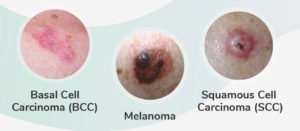Dr. Gil Y. Cortes, MD
 Melanoma is a cancer type that begins in the skin cells that create the pigment melanin. Melanoma usually manifests as a dark mole on the skin. However, it also rarely forms in other tissues, such as the eye or even intestines. The most noticeable sign of melanoma is the appearance of a new mole or a change in an existing mole or birthmark. People should be aware of any pigmented areas on the skin that appear abnormal in color, shape, size, or texture.
Melanoma is a cancer type that begins in the skin cells that create the pigment melanin. Melanoma usually manifests as a dark mole on the skin. However, it also rarely forms in other tissues, such as the eye or even intestines. The most noticeable sign of melanoma is the appearance of a new mole or a change in an existing mole or birthmark. People should be aware of any pigmented areas on the skin that appear abnormal in color, shape, size, or texture.
In 2018, an estimated 96,480 patients in the United States were diagnosed with melanoma, and about 7,230 patients died from the disease. With surgery, melanoma that is confined to the skin, is curable in 95 to 98 percent of cases. Unfortunately, if the lesion recurs (returns), gets thicker, or spreads from the skin to the lymph nodes or distant organs, it becomes much more dangerous.
Melanoma is categorized by stages. A particular stage of the disease gives an idea how far the cancer has spread. Essentially, there are five stages of melanoma. The first stage is called stage 0, or melanoma in situ. The last stage is called stage 4. Survival rates tend to go down at each stage of melanoma. However, it is important to keep in mind that survival rates are just estimates. Each person with melanoma is different, and your outlook or prognosis can vary based on many different factors.
Even more surprising is the realization that just millimeters separate the different stages of melanoma skin cancer. A stage 2 melanoma means the tumor has grown just over 2 millimeters in thickness. The five-year survival rate is 70-81 percent and the 10-year survival rate is approximately 60 percent. A stage 3 melanoma is one that has spread to additional areas besides the skin. At this point, radiation and other medication treatments are employed. The five-year survival rate for stage 3 melanoma drops to 40-78 percent and the 10-year survival rate drops to 24-68 percent.
According to the American Cancer Society, the 5-year survival rate for advanced or stage 4 melanoma is 15–20 percent. This means that an estimated 15–20 percent of people with stage 4 melanoma will be alive 5 years after diagnosis.
Doctors previously considered advanced melanoma to be untreatable, but today the outlook has significantly improved. Melanoma has historically been a disease that is difficult to treat with just medications and drug development made limited progress. However, in recent years, developments in molecular biology, have led to an increased understanding of the molecular functioning of melanoma which has resulted in the introduction of new insights into the role of oncogenes, immune checkpoints, and signaling pathways, all of which have accelerated the discovery rate of new medications to treat advanced melanoma. Breakthrough drug approvals in recent years, checkpoint inhibitors and MEK/BRAF combination therapies have prolonged survival and changed the prognosis for patients with advanced melanoma.
Because Melanoma is a type of skin cancer that can change its prognosis for patients with just millimeters of skin penetration. Early detection is always key. Everyone should have at a minimum yearly or annual skin exams by a trained professional to catch melanoma as early as possible. If there is a personal or family history of skin cancer or melanoma, screening is even more important.
Currently the recommended treatment of melanoma is a wide excision to remove the cancer and also evaluation to see if it has spread. If you have advanced melanoma, or it has spread, the prognosis can rapidly change. Drug development for melanoma has focused on cutaneous melanoma therapeutics and later stages of disease when surgery is not an option.
Advanced melanoma may be treated with a variety of modalities. These include surgery, radiation therapy or chemotherapy. Newer methods of treatment for advanced or stage 4 melanoma includes immunotherapy and targeted therapy. These treatments specifically target and destroy the cancer cells, avoiding damage to surrounding healthy cells. In about half of all melanoma cases there are mutations or genetic changes in a gene called the BRAF gene. People with melanoma who have this mutated gene can use targeted therapy drugs called BRAF inhibitors. These medicines attack the BRAF protein and shrink or slow the growth of the cancer cells.
Treatment can completely cure melanoma in many cases, especially when it has not spread extensively. However, melanoma can also recur. Fortunately, Melanoma is much more treatable today than it was a few decades ago. Monitoring moles and skin changes can help a person catch melanoma in the early stages and reduce the risk of it spreading.
It is natural to have questions about the treatment, its side effects, and the chances of cancer recurring. People with concerns should discuss them with a doctor who can offer advice that takes their medical history and overall health into account.
Gil Cortes, MD, FAAD
NOVU Dermatology
Practice Owner & Dermatologist
(352) 775-3565
NOVUDERMATOLOGY.COM
Rolling Oaks Professional Plaza
929 N. US Hwy 441 Suite 603
Lady Lake, FL 32159
 Central Florida Health and Wellness Magazine Health and Wellness Articles of the Villages
Central Florida Health and Wellness Magazine Health and Wellness Articles of the Villages



